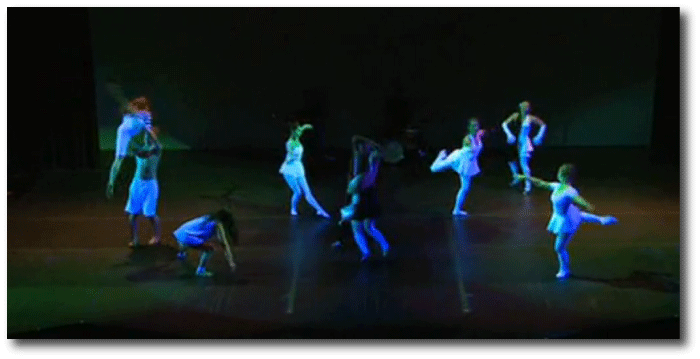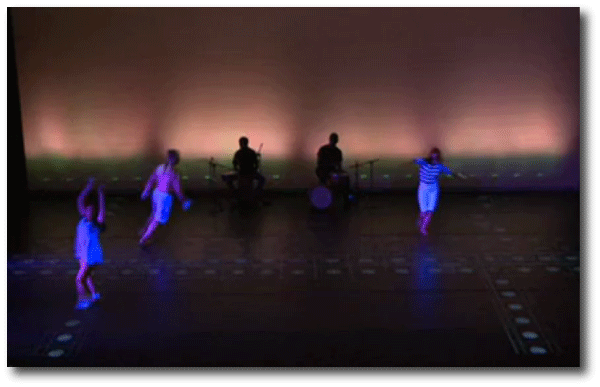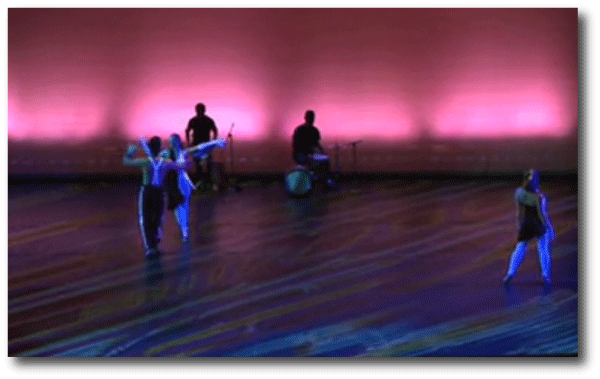I’ve written several times, most recently last year, about the Pythagorean Three-Body Problem, which has just marked its first century in the literature (See Burrau, 1913).
Assume that Newtonian Gravity is correct. Place three point bodies of masses 3, 4, and 5 at the vertices of a 3-4-5 right triangle, with each body at rest opposite the side of its respective length. What happens?
The solution trajectory is extraordinary in its intricate nonlinearity, and lends itself to an anthropomorphic narrative of attraction, entanglement and rejection, with bodies four and five exiting to an existential eternity of No Exit, and body three consigned to an endless asymptotic slide toward constant velocity.
This past academic year, I worked with Ted Warburton, Karlton Hester, and Drew Detweiler to stage an interpretive performance of the problem, along with several of its variations. The piece was performed by UCSC undergraduates and was part of the larger Blueprints year-end festival. Here is a video of the entire 17 minute program.
The first of the four segments is an enactment of the standard version of the problem (As set above), and was done with a ballet interpretation to underscore that this is the “classical” solution. Prior to joining the faculty at UCSC, Ted was a principal dancer at the American Ballet Theater, and so the cohoreography was in an idiom where he has a great deal of experience.
The score for the performance was performed live, and is based wholly on percussion parts for each of the three bodies. The interesting portion of the dynamics is mapped to 137.5 measures, which satisfyingly, last for three minutes and forty five seconds.
The nonlinearity of the Pythagorean Problem gives it a sensitive dependence to initial conditions. It is subject to Lorenz’s Butterfly Effect. For the second segment of the performance, we chose a version of the problem in which body three is given a tiny change in its initial position. Over time, the motion of the bodies departs radically from the classical solution, and the resolution has body three leaving with body five, while body four is ejected. A more free-flowing choreography was drawn on to trace this alternate version.
A fascinating aspect of the problem is that while the solution as posed is “elliptic-hyperbolic”, there exist nearby sets of initial conditions in which the motion is perfectly periodic, in the sense that the bodies return precisely to their initial positions, and the sequence repeats forever. In the now-familiar solution to the classical version of the problem, the bodies manage to almost accomplish this return to the 3-4-5 configuration at a moment about half-way through the piece. This can be seen just after measure 65, at which time body 4 (yellow), body 5 (green), and body 3 (blue) are nearly, but are not exactly, at their starting positions, and are all three moving quite slowly:
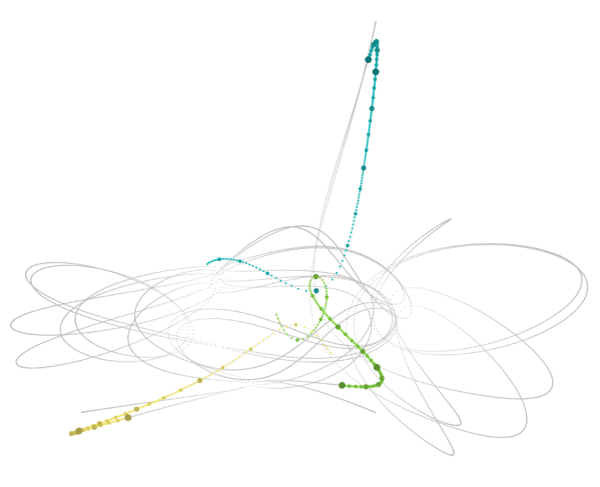
If the bodies all manage to come to rest, then the motion must reverse and retrace the trajectories like a film run backward. With this realization, one can plot the summed kinetic energy of the bodies, which is a running measure of the amount of total motion. Note the logarithmic y-axis:
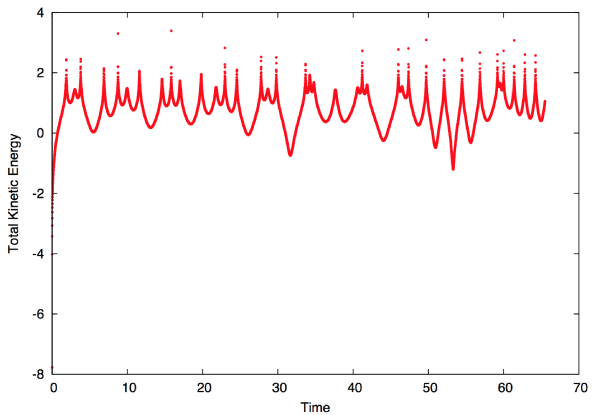
The bodies return close to their initial positions at Time = 31, at which time there is a local minimum in the total kinetic energy.
Next, look at the effect of making a small change in the initial position of one of the bodies. To do this, I arbitrarily perturbed the initial x position of body 3 by a distance 0.01 (a less than one percent change), and re-computed the trajectories. The kinetic energy measurements of this modified calculation are plotted as gray. During the first half of interactions the motion is extremely similar, but that the second half is very different. Interestingly, the gray curve reaches a slightly deeper trough at Time = 31. The small change has thus created a solution that is slightly closer to the pure periodic ideal.
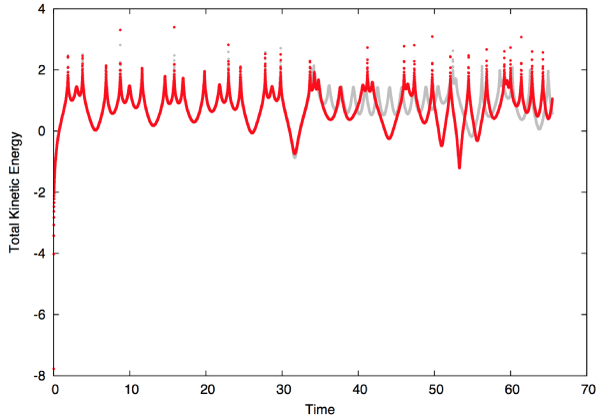
I next used a variational approach to adjust the initial positions in order to obtain solutions that have progressively smaller Kinetic energy at time 31. In this way, it’s easy to get arbitrarily close to periodicity. The motion in a case that is quite close to (but not quite exactly at) the periodic solution is shown just below. After measure 65, the bodies arrive very nearly exactly at their initial positions, and, for the measures shown in the plot below, they have started a second, almost identical run through the trajectories.
The perfectly periodic solution occurs when bodies 4 and 5 experience a perfect head-on collision at time ~15 (around measure 33). If this happens, bodies 4 and 5 effectively rebound back along their trajectory of approach, and the motion retraces, therefore repeating endlessly. Here’s the action which shows the collision:
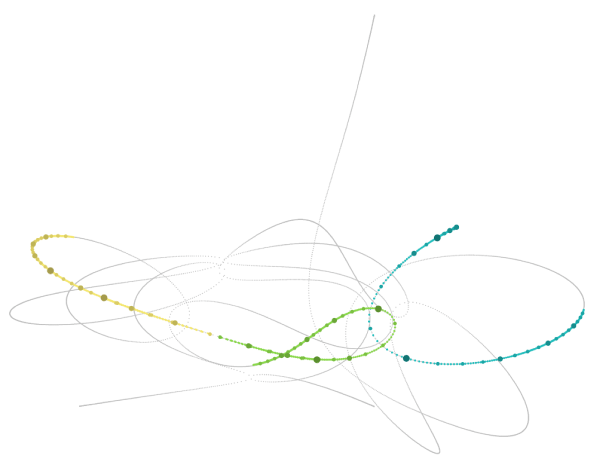
Ted suggested that Tango and Rhumba could be the inspiration for the choreography of the perfectly periodic solution. I was skeptical at first, but it was immediately evident that this was a brilliant idea. The precision of the dancing is exceptional, and the emotion, while exhibiting passion, is somehow also controlled and slightly aloof. No jealousy is telegraphed by motion, allowing the sequence to repeat endlessly in some abstract plane of the minds eye.

